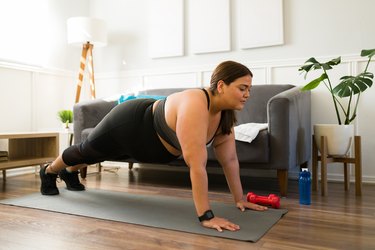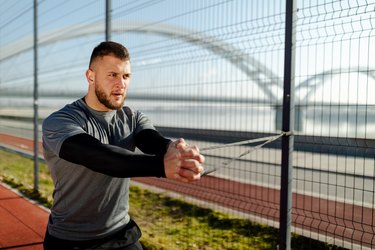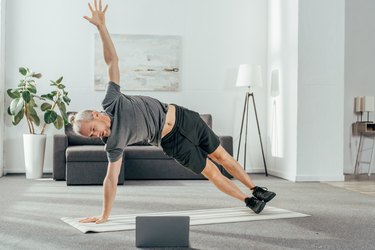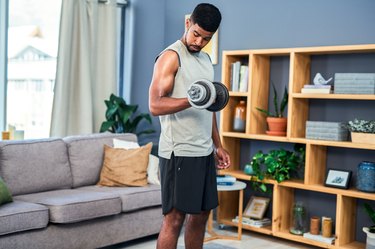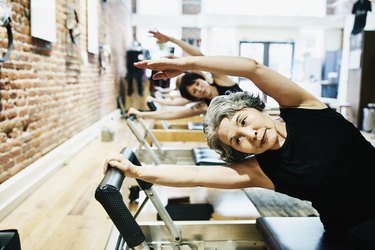
Pilates is an effective and challenging workout. It targets and tones smaller muscle groups in your body and activates your core to not only increase strength but improve your alignment and posture. However, you'll only be able to reap these amazing benefits by doing Pilates workouts correctly.
There are actually a few common mistakes you may be making during your Pilates workouts without even realizing it, which can hamper your progress.
Video of the Day
Video of the Day
Watch out for these major "don'ts" when it comes to Pilates workouts, according to Pilates instructors, as they may interfere with your performance and your results.
1. You Don't Activate Your Core
Activating your core muscles is critical for every Pilates movement. By engaging these muscles, you'll improve your strength, and alignment and posture. Poor core activation can lead to overworking the wrong muscle groups during a given move, which could lead to pain and injury.
For instance, during an exercise that requires heavy core activation, you may instead engage your hip flexors or lower back muscles more if your abdominals are weak, according to Sarah Brooks, PSC, CPT, certified pilates instructor, certified personal trainer and founder of Brooks Pilates. Your hip flexors or back muscles — the stronger muscles — must then work harder to compensate and take over the movement.
"We want to always engage the core to avoid bothering the back and to protect the spine," Brooks tells LIVESTRONG.com.
If you're unsure how to activate your core, the first step is to decrease the range of motion when engaging your muscles and see if it helps, Brooks says. Also, try tucking your pelvis under a little and lift your lower abs in and up as a way to wrap your rib cage together and keep your hips high.
Strengthening your core and midsection lessens the risk of hurting your back and spine, as well as hip flexors, due to weakness in core muscles. The stronger your abs, the less you'll feel tension in your back. Oblique work, including side bends, side planks, and the Pilates hundred exercise (which you can do on a mat or the reformer) can be particularly helpful.
"When you work your obliques, you may feel it in your back because the obliques are literally connected to it, which isn't necessarily bad, but just means you need to strengthen your back just as often as your abdominal wall," Brooks says.
2. You Don't Engage Your Smaller Muscles
At the gym, you're likely to focus on larger muscle groups (glutes, quads, hamstrings, back, chest), rather than smaller muscle groups (shoulders, biceps, triceps, calves). However, Pilates targets smaller muscles using a shortened range of motion.
Strengthening smaller muscle groups, in addition to large ones, does matter, though. If you don't work your smaller muscles, it'll be harder to boost strength overall to best support those larger muscle groups, Brooks says.
So, outside of Pilates it's important to include exercises in your routine that target these small muscles to benefit you inside the studio. For instance, instead of doing lunges, which works your whole glute, try something like a side-lying leg lift, which focuses on the smaller gluteus minimus and is used for many Pilates moves.
3. You Breathe Incorrectly or Hold Your Breath
Pilates is all about the breathwork. Breathing properly is important for many reasons, like connecting to your core more deeply to assist with movement and promoting blood circulation and oxygen supply to your muscles, Brooks says.
If you hold your breath, you limit your ability to breathe with full capacity, activate your muscles and receive fresh, oxygenated blood for blood flow supply and good circulation throughout your body and muscles.
"The way I teach breathwork is to exhale on the point of exertion, which means I usually inhale in preparation for the movement and then exhale when exerting," Brooks says.
It's OK if you don't do what's considered "proper breathing," just as long as you're breathing (so, don't hold it in!). It takes time to learn and every exercise is different; however, a good rule of thumb is to inhale as you prepare and exhale as you start the movement.
To help you get in touch with your breathing for slower, controlled movement, try this exercise:
- Lie down on a mat with your legs and arms extended.
- Tuck your chin into your neck and take a big inhale.
- On the exhale, roll your spine up vertebra by vertebra until you're sitting up tall.
- Take a big inhale.
- On an exhale, roll back down vertebra by vertebra until you're back to the starting position.
4. You Rush Through Movements
Pilates isn't a workout where you're sprinting or rushing through exercises, such as with HIIT training, boxing workouts or cycling, for example. Instead, it's about being slow, steady and intentional with your movements so you can execute them with control.
If you're new to Pilates, starting slow and in control is essential. From there, you can determine changes in pace and progression based on the level of control you've established during movement. It's not until you're really experienced in Pilates that you can pick up the pace, Brooks says.
5. Your Form and Body Alignment Is Off
A lack of focus on form and body alignment can not only make your Pilates workouts less effective, but it can also lead to pain or injury.
"For example, if you're intending to use your core muscles for something but instead let your lower back take over, you run the risk of hurting yourself and potentially straining muscles that don't need to be as involved," says Kat Wiersum, PSC, CPT, certified Pilates instructor at Amplified Pilate.
Slow down, focus on your breath and check in on what you're feeling and where. If something feels off, take a moment to reassess or check in with your instructor.
"All bodies are different, and you might need to make a subtle adjustment based on your personal strengths, anatomy and experiences to make an exercise more effective for you," Wiersum tells LIVESTRONG.com.
For instance, modifications can help secure better form and alignment. "Try bending or straightening your knees, playing with a tucked versus neutral pelvis position or putting your arms in a different position," Wiersum suggests. An instructor can provide insight into the pros and cons associated with these variations and help you figure out which positions are ideal for you.
6. You Use the Reformer Without Adequate Knowledge
If you're using the reformer wrong, there's the potential for injury. "People can fall off the reformer if they don't know how to use it," Brooks says. "For instance, if you're kneeling on the machine and you just pull on the straps without thinking, you might fall on your face."
To be safe, learn how to do reformer Pilates workouts with an instructor nearby for supervision, safety and guidance.
Brooks' biggest suggestion: "Do not try to use one by yourself. Instead, seek out one-on-one help with an instructor to learn the apparatus, equipment and how it works, as there are many different adjustments that need to be made with regards to height, weights on each spring and different tension levels."
With more understanding as to how it works, you'll be able to receive the reformer machine's numerous benefits. With experience, it'll be easier to make changes and manipulate measures, like resistance or tension, by determining when's best to go heavier or lighter based on the exercises you're doing.
